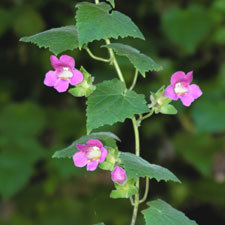 Creeping gloxinia
Creeping gloxinia
Common name: Creeping gloxinia
Botanical name: Lophospermum erubescens
Management programme: Eradication
Where is it originally from?
Native to Mexico, creeping gloxinia was introduced to New Zealand as a garden plant before becoming naturalised in 1981.
Why is it a pest?
- Creeping gloxinia climbs over, smothers and kills the plants underneath as they cannot compete with the fast growth rate of creeping gloxinia.
- It spreads by seed dispersal and has well-equipped seeds with wings to help them lift and be carried along in winds.
Where is it found?
Only known to be in western Bay of Plenty, in low numbers. Creeping gloxinia is found in forest margins and wherever the seeds are blown by the wind. It can end up in backyards, open areas, shrub land and open rocky areas.
What does it look like?
- Sprawling perennial vine, climbs to over 4m.
- Soft hairy, triangular leaves with toothed margins.
- White, purple, or rose coloured, tubular flowers (October to March), very obvious and bright, about 7cm long.
- Round fruit capsules with winged seeds.
What are the rules?
Eradication
Creeping gloxinia is an Eradication pest. This means that it is already present in the region but is limited in the extent of infestation. The eradication of these organisms is a feasible and cost-effective solution.
Bay of Plenty Regional Council is responsible for control of creeping gloxinia in the region. Please contact the Bay of Plenty Regional Council if you think you have found creeping gloxinia.
How do you get rid of it?
Please do not attempt to control creeping gloxinia yourself. Contact Council and a biosecurity officer will get in touch to get more information and arrange a site visit.
Images






